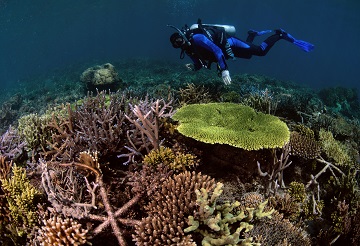SATS-201 a reefs symphony- website.jpg

A coral reef, three years after restoration. Credit: The Ocean Agency
As any parent or teacher knows, a roomful of kids suddenly going silent could mean trouble. As it turns out, coral reefs have their own soundscape, and a quieter reef may also suggest trouble.
Scientists can monitor a reef’s changes by eavesdropping on the sounds made by its inhabitants. This approach provides more information than visually observing the reef or calculating coral coverage, and it tells biologists more about the reef’s health.
Researchers from two universities in the United Kingdom lead the Mars Coral Reef Restoration Project, which restores coral reefs in central Indonesia. To measure their progress they needed a way to tell whether the reefs were actually recovering, so in 2018 and 2019 the scientists made a series of audio recordings of the reefs after one to three years of restoration. Then they analyzed the soundscapes of these reefs and compared them to both healthy and degraded reefs. Although the sounds of restored reefs differed from existing healthy reefs, the restored reefs boasted a similarly broad diversity and frequency of sounds as the healthy reefs, suggesting the restored ecosystems were healthy and full of a variety of critters. The sounds from restored reefs had much richer diversity than degraded reefs.
So what exactly were the sounds emanating from the restored reefs? Sunrise brought growls along with a few whoops and laughs, followed by three dozen scrapes in the morning and afternoon. They also heard some foghorn sounds in the afternoon before knocks, croaks and grunts rose up during sunset. The nighttime soundtrack included a mix of purrs and raspberries before the growls and grunts of sunrise signaled a new day. All of these sounds were made by the animals living on the restored reefs.


